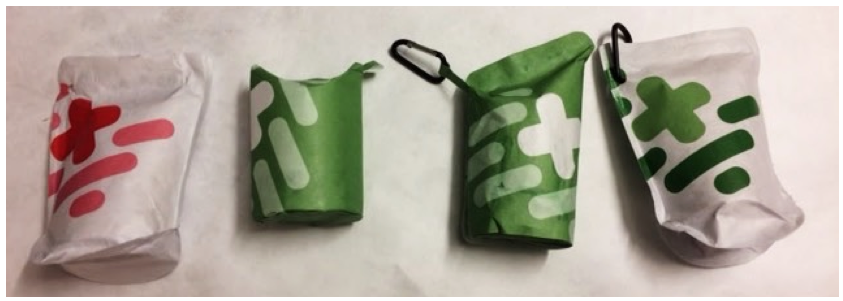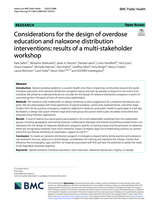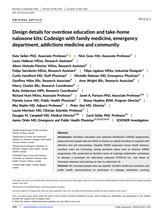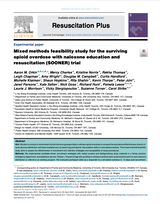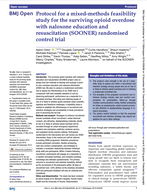|
/ Project Overview
Surviving Opioid Overdose with Naloxone Education and Resuscitation
Key Words: Addiction, Mental Health, Basic Life Support, Design Thinking, Emergency Medicine, Resuscitation, Family Medicine, Harm Reduction, Overdose Prevention, Naloxone, Opioids Objective: Expanding overdose first aid education and naloxone distribution (OEND) to a wider range of settings (such as family medicine, addiction clinics, and emergency departments) could increase the number of potential lay responders reached by OEND programs |
/ Collaborators
PI - Dr. Aaron Orkin, Co-PI Dr. Carol Strike, Co-PI Sr. Doug Campbell, Co_PI Dr. Laurie Morrison,Co-PI Dr. Peter Juni, Co-PI Dr. Kate Sellen, Nick Goso, Richard Hunt, Dr. Janet Parsons, Laura Halleran, Alison Mulvale-Fletcher, Dr. Felipe Sarmiento, Filipe Ligabue, Dr. Curtis Handford, Dr. Michelle Klaiman, Geoffrey Milos, Amy Wright, Mercy Charles, Ruby Sniderman, Dr. Pamela Leece, Shaun Hopkins, Dr. Rita Shahin, Kristine Norris, Rekha Thomas, Dr. Leigh Chapman, Douglas Campbell, Kevin Thorp, Dr. Janet Parsons, Dr. Vicky Stergiopoulos, Dr. Suzanne Turne
/ Sponsor(s): Canadian Institutes of Health Research, St. Michael's Hospital, Toronto Public Health, Mount Sinai Hospital |
|
/ Abstract
The SOON-ER project aims to design an evidence-based Overdose Education and Naloxone Distribution (OEND) first aid toolkit, to be offered in a range of settings, that allows for ultra-brief training of overdose first aid for potential lay responders with nasal naloxone.
/ Research Process
OCAD University led the design phase of the SOON-ER project, addressing the need for an integrated design approach to expanding lay response to overdose, addressing stigma, and creating an open design that can easily be shared and replicated. The design process included extensive community and stakeholder engagement in iterative workshops over 9 months, engaging over 100 community members and clinicians.
|
/ Results
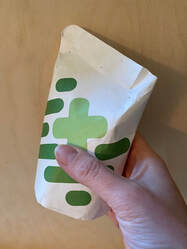
The result was the development of an ultra-brief first aid training animation and the creation of a toolkit with nasal naloxone for lay response to overdose that can be manufactured locally. Key aspects of the design process addressed the context of overdose, stigma, and marginalisation. Currently, the toolkit is being tested against existing training and access. The success of patient responses to opioid overdose situations will be evaluated and compared in simulated overdose situations. Project results from SOON-ER are already being translated into provincial and national initiatives on overdose prevention.
/ For more on this project please visit: Resuscitation simulation among people who are likely to witness opioid overdose |
|
|
(2023) From design to action: participatory approach to capacity building needs for local overdose response plans
Authors: Maryam Mallakin, Christina Dery, Yordanos Woldemariam, Michael Hamilton, Kim Corace, Bernie Pauly, Triti Khorasheh, Caroline Bennett AbuAyyash, Pamela Leece, and Katherine Sellen.
|
|
(2023) Considerations for the design of overdose education and naloxone distribution interventions: results of a multi-stakeholder workshop
Authors: Kate Sellen, Benjamin Markowitz, Janet A. Parsons, Pamela Leece, Curtis Handford, Nick Goso, Shaun Hopkins, Michelle Klaiman, Rita Shahin, Geoffrey Milos, Amy Wright, Mercy Charles, Laurie Morrison, Carol Strike, Aaron Orkin & SOONER Investigators
|
|
(2022) Design details for overdose education and take-home naloxone kits: Codesign with family medicine, emergency department, addictions medicine and community
Authors: Kate Sellen PhD, Nick Goso MA, Laura Halleran MDes, Alison Mulvale-Fletcher MDes, Felipe Sarmiento MDes, Filipe Ligabue MDes, Curtis Handford MD, Michelle Klaiman MD, Geoffrey Milos BSc, Amy Wright BSc, Mercy Charles BSc, Ruby Sniderman MPh, Richard Hunt MDes, Janet A. Parsons PhD, Pamela Leece MD, Shaun Hopkins BSW, Rita Shahin MD, Peter Jüni MD, Laurie Morrison MD, Douglas M. Campbell MD, Carol Strike PhD, Aaron Orkin MD, SOONER Investigators
|
|
(2021) Mixed methods feasibility study for the surviving opioid overdose with naloxone education and resuscitation (SOONER) trial
Authors: Aaron M. Orkin, Mercy Charles, Kristine Norris, Rekha Thomas, Leigh Chapman, Amy Wright, Douglas M. Campbell, Curtis Handford, Michelle Klaiman, Shaun Hopkins, Rita Shahin, Kevin Thorpe, Peter Jüni, Janet Parsons, Kate Sellen, Nick Goso, Richard Hunt, Pamela Leece, Laurie J. Morrison, Vicky Stergiopoulos, Carol Strike.
|
|
(2019) Protocol for a mixed-methods feasibility study for the surviving opioid overdose with naloxone education and resuscitation (SOONER) randomised control trial
Authors: Aaron Orkin, Douglas Campbell, Curtis Handford, Shaun Hopkins, Michelle Klaiman, Pamela Leece, Janet A Parsons, Rita Shahin, Carol Strike, Kevin Thorpe, Kate Sellen, Geoffrey Milos, Amy Wright, Mercy Charles, Ruby Sniderman, Laurie Morrison.
|
Proudly powered by Weebly

